Last Updated on April 5, 2021
Do you want to lose weight with the help of vegetables high in fiber? Then you have come to the right place. In this blog post, you’ll learn which veggies are good sources of this desirable substance.
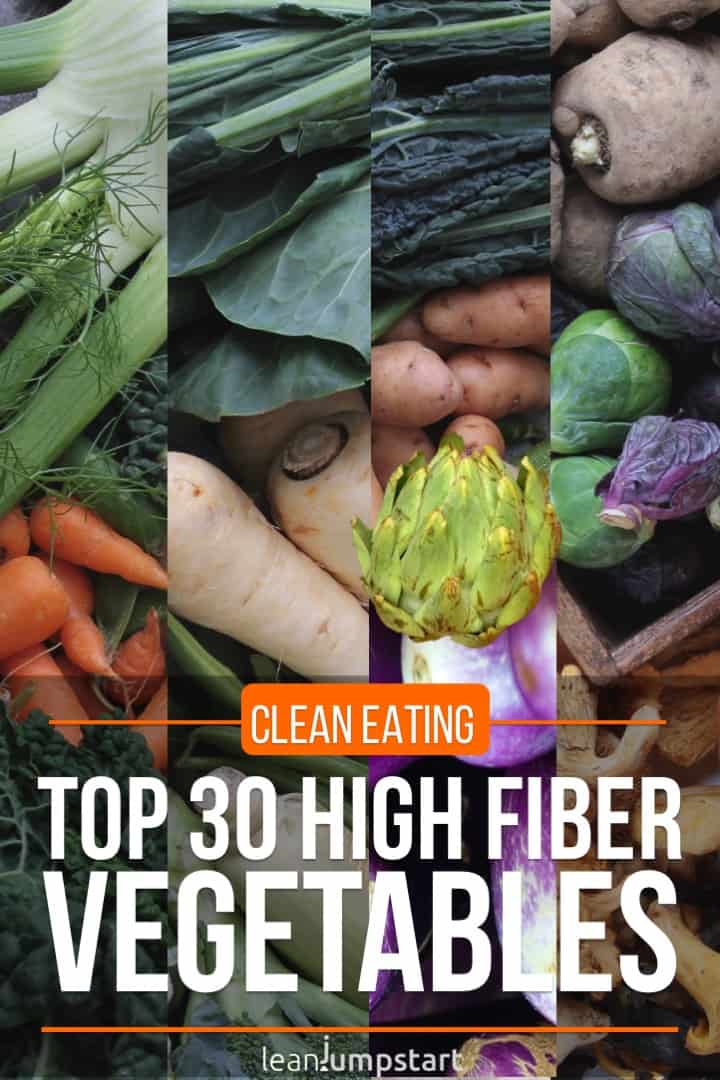
Scientists could prove that those who eat foods with lots of roughage find it usually easier to lose pounds or keep their shape. At the same time, we protect ourselves effectively against heart disease and other chronic illnesses of a typical Western lifestyle. Among all food groups, vegetables are those low-calorie foods that you can eat to your heart’s content. If you want to learn more about the slimming secrets of roughage, make sure to read until the end of this blog post.
What is fiber?
Fiber is a type of carbohydrate that helps prevent constipation, hemorrhoids, high cholesterol, and high blood pressure by trapping excess cholesterol in the gut, rather than allowing it to be absorbed. Fiber-rich foods include whole grains, fruits and vegetables, beans, nuts, and seeds.
You can click through for my top high fiber food you should eat to learn more about foods that are high in fiber.
What is a high fiber diet?
A high fiber diet is one in which you consume large quantities of fiber. Fiber is found in many foods and is an important component of a healthy diet. It can help lower cholesterol, which may prevent diabetes and heart disease. High fiber vegetables will also reduce the risk of cancers and will also keep your gut healthy.
What vegetables are high in fiber?
Last month I shared with you the Top 26 high-fiber fruits. In this blog post we take a closer look at best veggies to eat:
- In general, the darker the color of the veggies, the higher the roughage content (with exceptions).
- Cabbage types and root vegetables are excellent sources, but mushrooms can also help to replenish your roughage account.
- Solid varieties such as carrots and fennel contain significantly more of this precious nutrient than water-rich varieties like zucchinis or cucumbers.
- Cooked vegetables tend to contain higher amounts of soluble fiber. Acting as gelling agents in the gut, the soluble ones are particularly beneficial in preventing chronic diseases.
In the following, I’ve researched for you the highest fiber vegetables and hand-picked some easy clean eating recipes. The data is based on the United States Department of Agriculture Agricultural Research Service (USDA).
1. Artichokes, raw
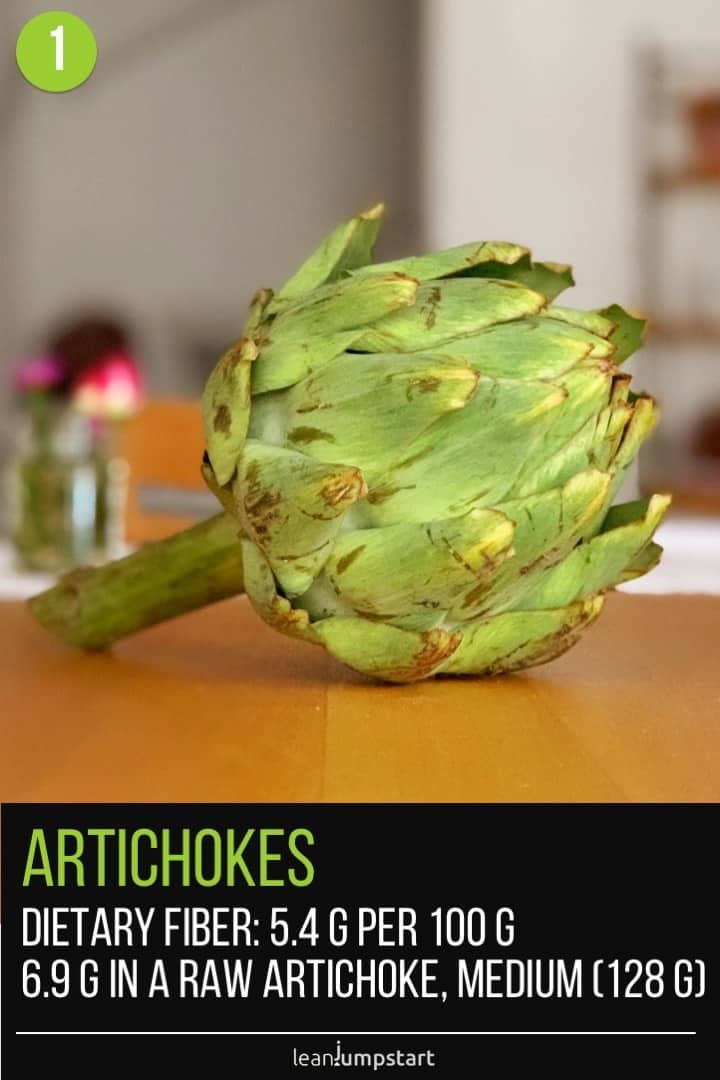
As vegetables with the most amounts of fiber, artichokes are still clearly underrepresented in the majority of healthy meals.
Many people just don’t know how to cook artichokes. Whether as a main ingredient, side dish or in a dip – these unusual veggies can be used in many ways.
The roughage rich produce can also promote liver and bile activity and lower cholesterol levels. As one of the most important medicinal plants, the artichoke is also available as juice, tincture or tea.
Fiber content: 5.4 g per 100 g (1), or 6.9 g in a raw artichoke, medium (128 g)
Check out in this context one of my favorite dip recipes: easy spinach artichoke dip
2. Parsnips, raw
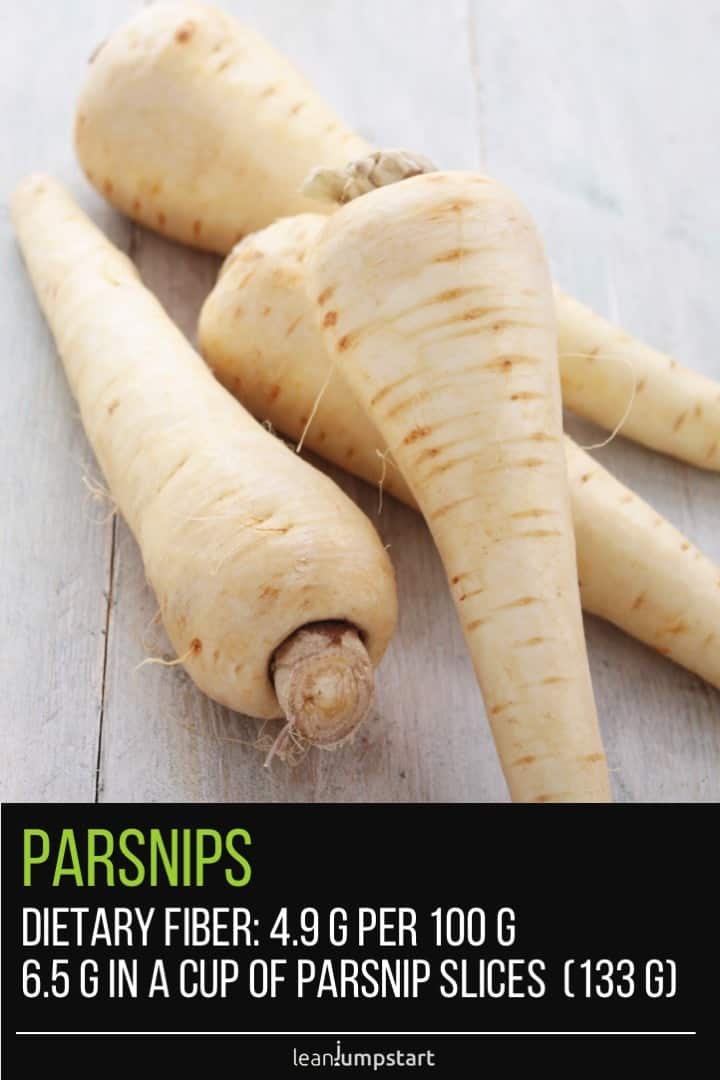
The root contains a quite large amount of complex carbohydrates (sugar, starch, and the soluble fiber pectin). Hence it satiates for a long time. In addition to its typical spicy taste, the essential oil in parsnip has also a slightly antibacterial effect.
Parsnips contribute to our daily vitamin C requirements with around 18 mg per 100 g. B vitamins and minerals (especially phosphorus and calcium) complete the nutrient package.
Fiber content: 4.9 g per 100 g (2), or 6.5 g in a cup of raw parsnip slices (133 g)
Ready for a try? This hearty root vegetable soup is a winner: Parsnip soup with potatoes
3. Kale, raw
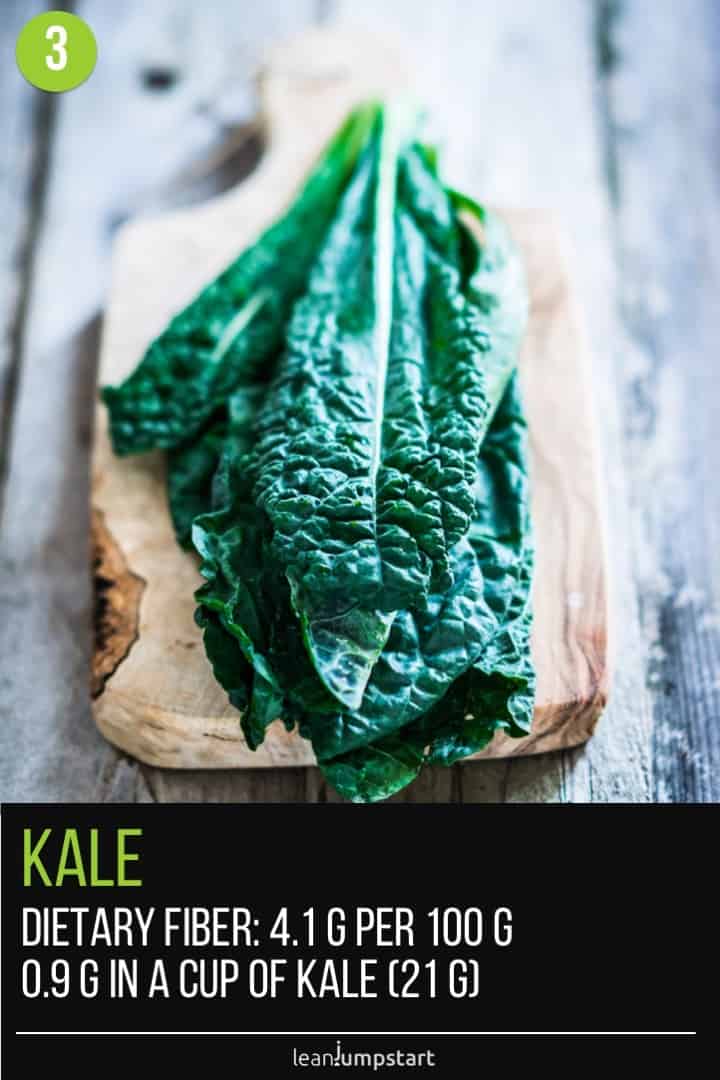
With its high dietary roughage content, kale makes a positive contribution to our digestion. You can get 1 to 2 grams of insoluble fiber from a half cup of cooked kale.
It is also the cabbage type with the highest amount of protein and carbohydrates. The combination of minerals and vitamins is also impressive. The winter vegetable contains potassium, calcium, and iron as well as vitamins from the group of B vitamins, vitamin C and vitamin E.
Fiber content: 4.1 g per 100 g (3), or 0.9 g in a cup of kale (21 g)
Try out my Kale pesto to create an excellent whole grain pasta dish.
4. Mushrooms, Chanterelle, raw
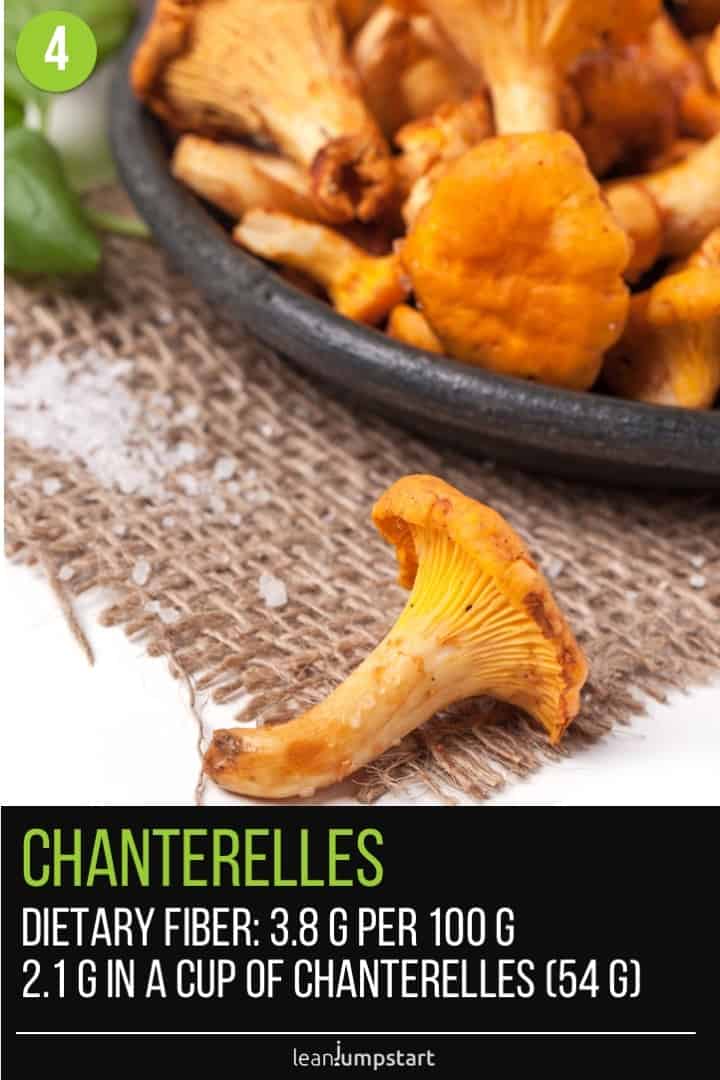
Like all edible mushrooms, the delicate and aromatic chanterelles are also a delicious and healthful treat. Because chanterelles consists of 92 % of water, vitamins and minerals are only found in tiny amounts.
These skinny foods are extremely low in fat and calories and at the same time rich in roughage!
Fiber content: 3.8 g per 100 g (4), or 2.1 g in a cup of raw chanterelles (54 g)
5. Brussel Sprouts, raw
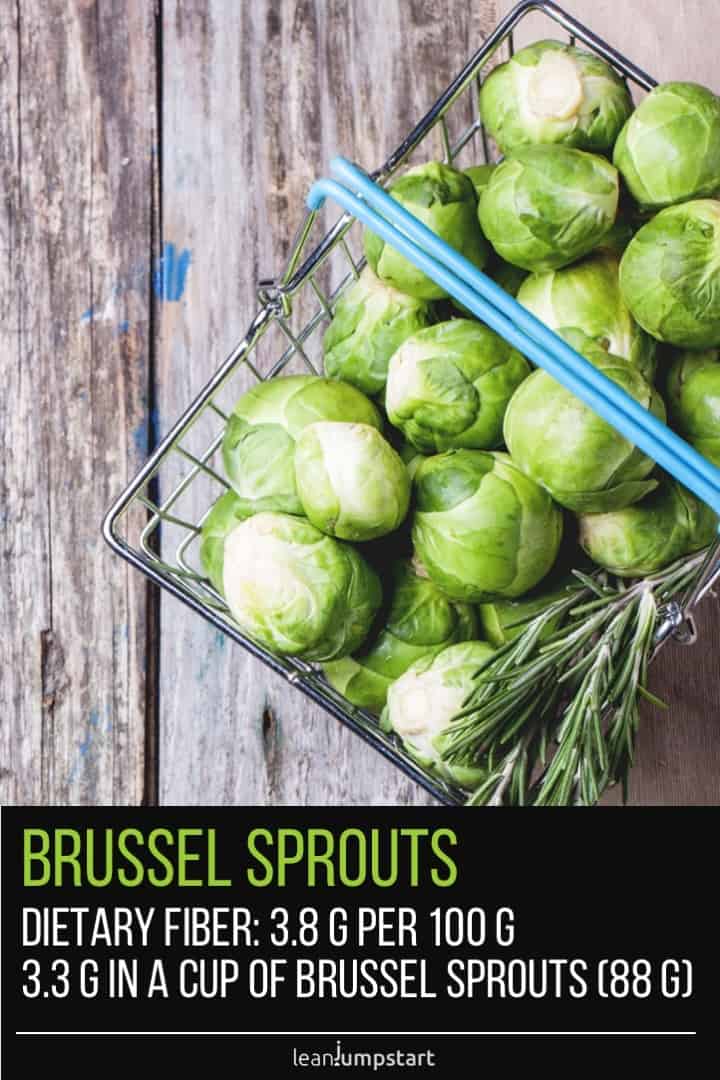
These cabbage types are real vitamin bombs, scoring with plenty of B vitamins, potassium and zinc. And naturally, also the fiber in Brussel sprouts is significant.
Due to their low water content, the small balls contain slightly more calories than other cruciferous vegetables. But with almost no fat, Brussel sprouts are perfectly suitable for the weight-conscious gourmets.
Fiber content: 3.8 g per 100 g (5), or 3.3 g in a cup of Brussel sprouts (88 g)
If you think you don’t like them then you have to taste my Bang Bang roasted Brussel sprouts.
6. Beet greens, raw
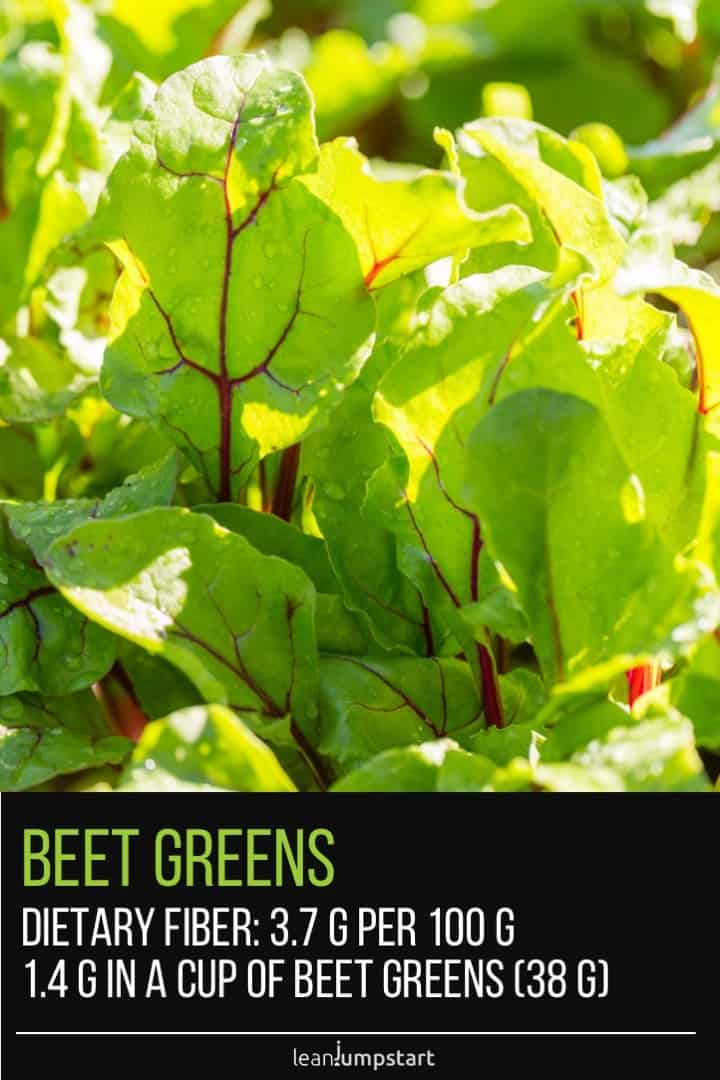
Not only the roots but also the greens of the beet are nutritionally valuable. The leaves are excellent sources of vitamins A, B6, C, and K, but also rich in fiber, iron, potassium, and magnesium.
In addition, beet greens have hardly any calories, which qualifies them for a calorie- or fat-reduced high fiber diet.
Fiber content: 3.7 g per 100 g (6), or 1.4 g in a cup of beet greens (38 g)
Here is a flavorful Thai salad, which I bedded on these high-fiber greens.
7. Cabbage, savoy, raw
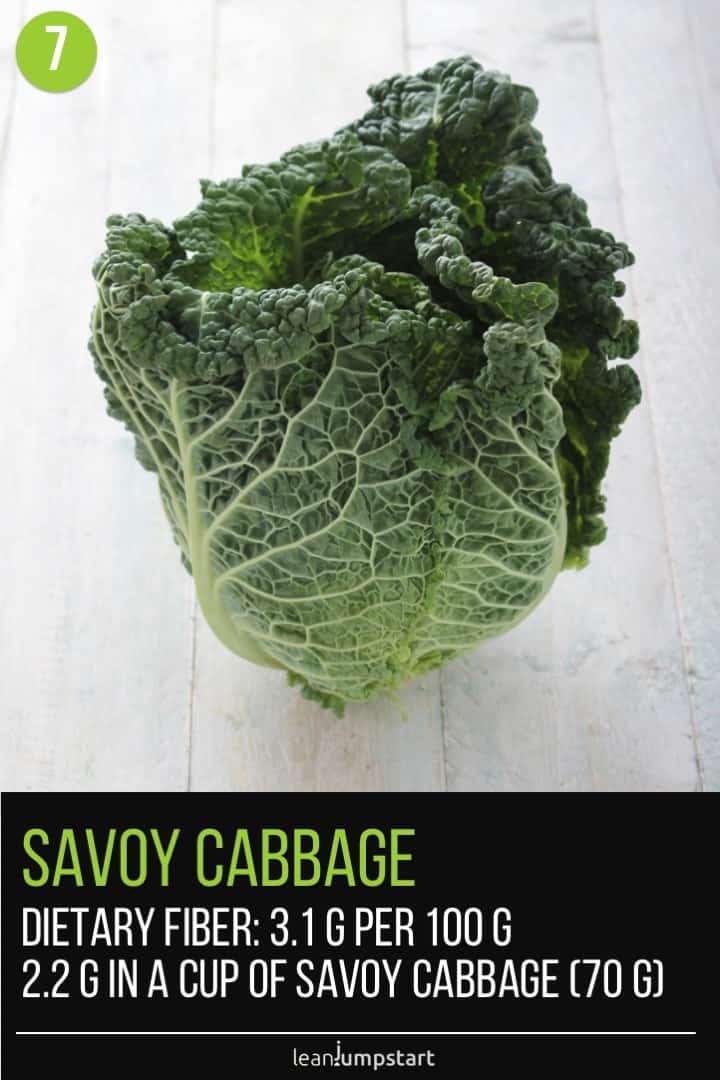
Like other cruciferous vegetables, savoy cabbage contains a wealth of valuable ingredients. This high fiber low-calorie food is perfect for people who want to lose weight.
Especially beneficial for health are the contained glucosinolates. These substances are responsible for the typical cabbage taste. Glucosinolates have an antibacterial effect, strengthen the immune system and can help to reduce cholesterol levels.
Savoy cabbage contains also three times as much folic acid as the other cabbage types.
Fiber content: 3.1 g per 100 g (7), or 2.2 g in a cup of shredded savoy cabbage (70 g)
You will love this easy, nutrient-dense snack idea: Savoy cabbage chips
8. Fennel, bulb, raw
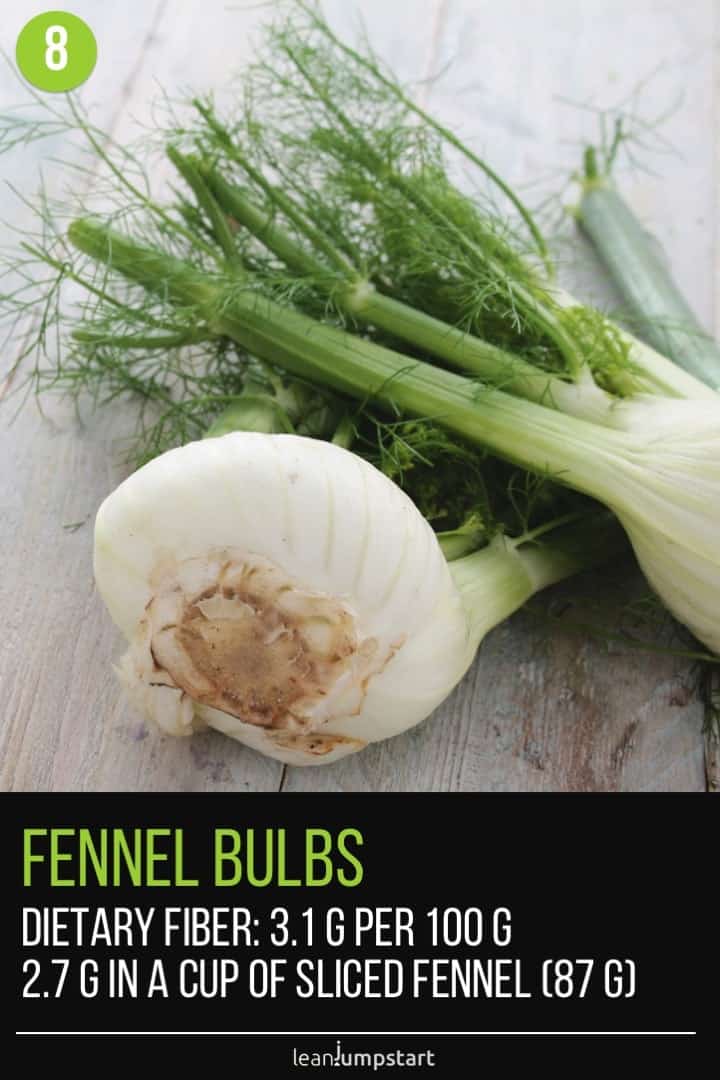
The tuber is also known as food with many healing powers. Fennel’s nutrients bind toxins and fats in the intestines. This not only has a detoxifying effect but also lowers cholesterol and blood fat levels.
Fennel is also a tried and tested household remedy for coughing as well as for disorders of the gastrointestinal tract. In addition, the bulb strengthens the immune system and increases cell activity.
Fiber content: 3.1 g per 100 g (8), or 2.7 g in a cup of sliced fennel (87 g)
This simple raw food recipe is a delicious starter: Fennel salad
9. Eggplant, raw
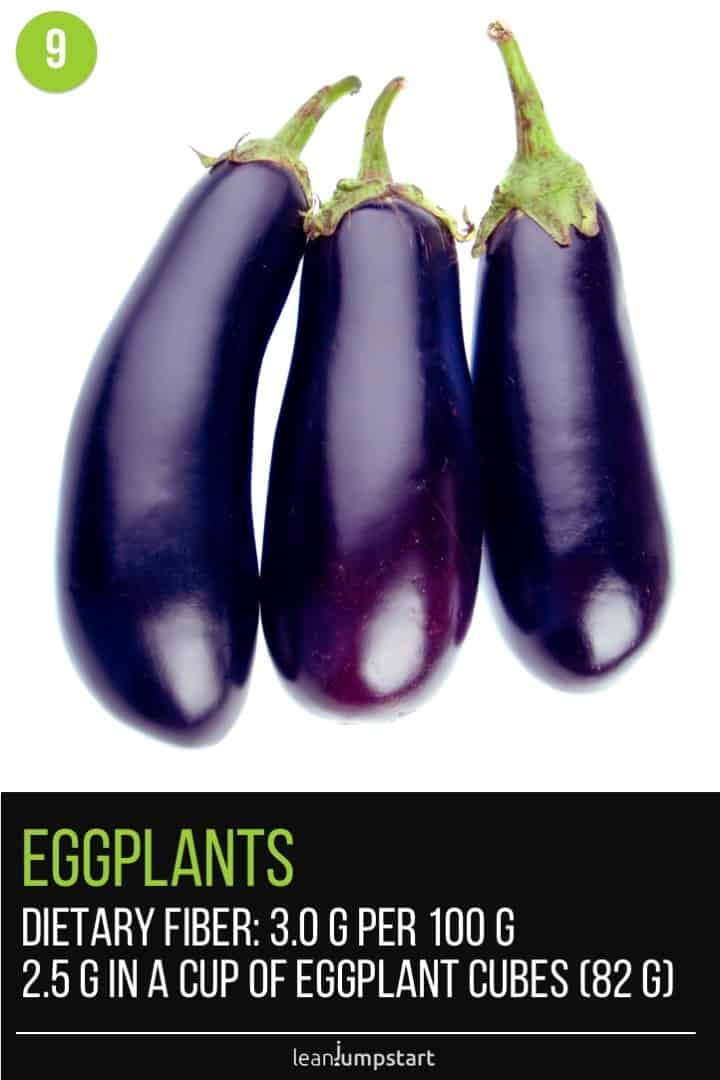
The soluble fibers of this nutritionally-dense food with just a few calories can lower elevated cholesterol levels (LDL cholesterol).
Due to its potassium and roughage content, eggplants promote healthy heart activity and can help maintain stable blood sugar levels and blood pressure.
With the support of its natural bitter substances, these shade vegetables also stimulate bile secretion and protect the digestive system.
Fiber content: 3.0 g per 100 g (9), or 2.5 g in a cup of eggplant cubes (82 g)
Stuffed aubergine canoes with chickpeas are a great highlight on any festive menu: Oven baked eggplant
10. Sweet Potato
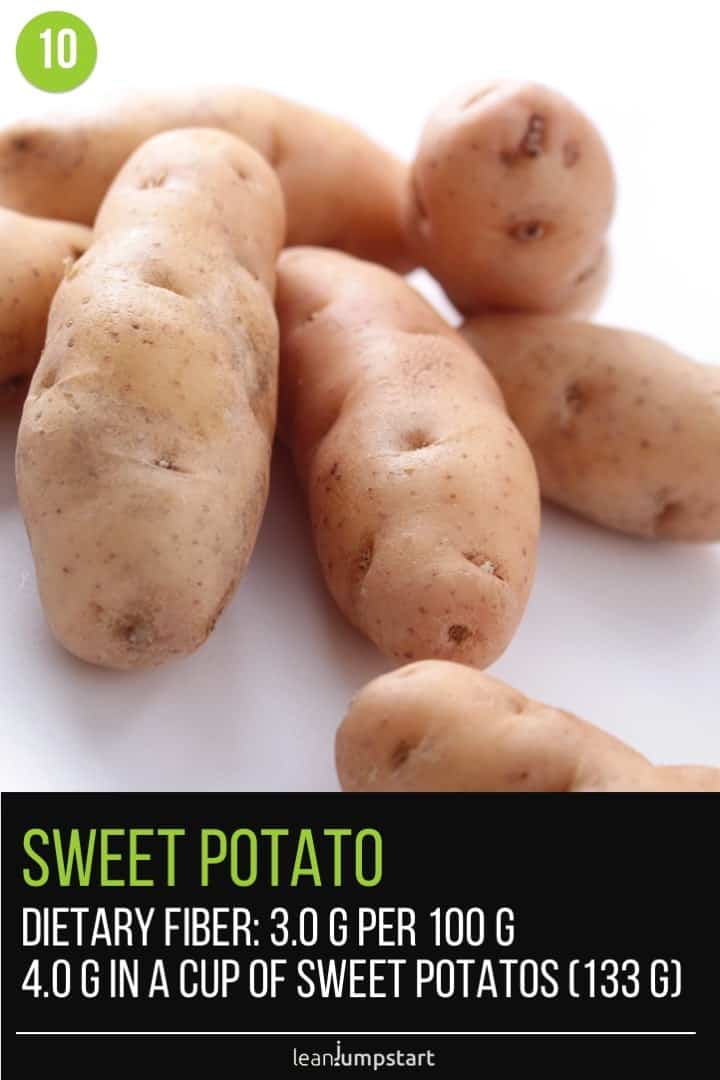
The fiber in sweet potatoes is significant and higher than that in white potatoes. The after peeling orange vegetable provides a longer satiety effect and protects against cravings.
The beta-carotene content in sweet potatoes is, almost as high as in carrots. No other low-fat food provides as much of the fat-soluble vitamin E that protects cells from premature aging.
100 grams of sweet potatoes cover a third of the required daily intake of vitamin E.
Fiber content: 3.0 g per 100 g (10), or 4.0 g in a cup of sweet potato cubes (133 g)
Do you have a sweet tooth? Then these filling whole foods snacks (in moderation) are perfect for you: Baked sweet potato toast
11. Carrots, raw
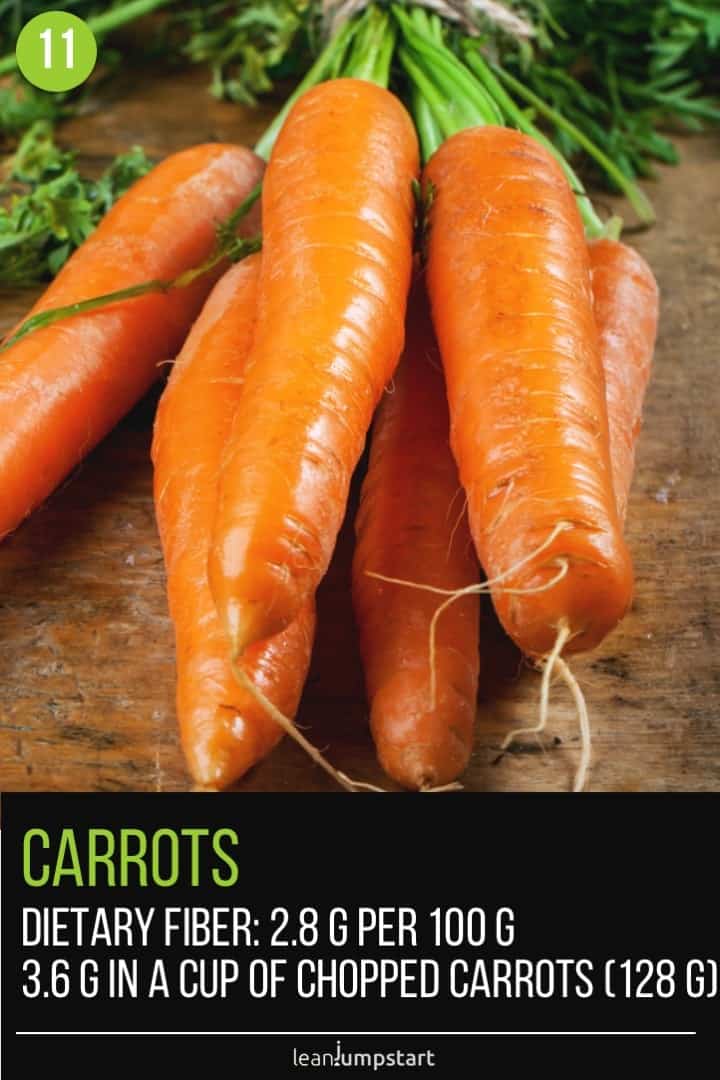
This popular root contains plenty of beta-carotene in addition to beneficial fiber and complex carbohydrates. Our body can transform beta-carotene into vitamin A, which is good for our eyes, skin, and hair.
For this transformation, our body needs a little bit of fat. That’s why you should always prepare carrots with some oil or nuts and seeds. The same is true for sweet potatoes, mentioned above.
Fiber content: 2.8 g per 100 g (11), or 3.6 g in a cup of chopped carrots, raw (128 g)
A creative appetizer or veggie snack is this spiralized carrot recipe.
12. Broccoli, raw
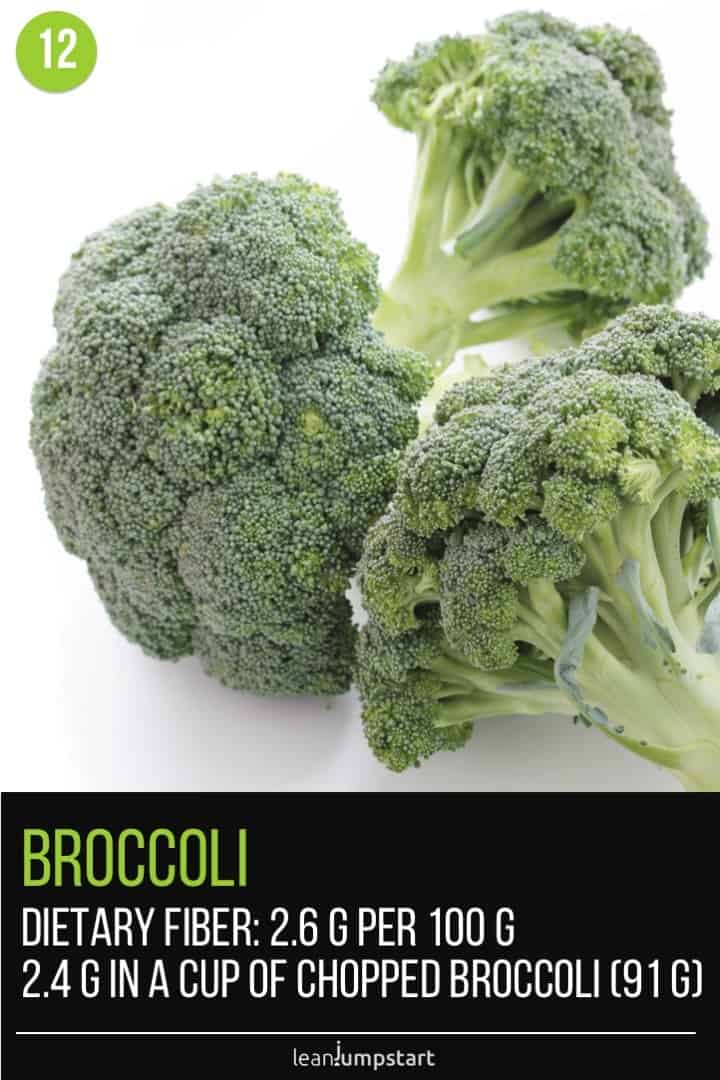
Though not everyone loves these green, most nutritious vegetables, they are good sources of fiber. Besides regulating the colon, the soluble fiber in broccoli acts as a prebiotic and feeds the beneficial gut bacteria.
In addition, the nutrient bomb contains a great deal of magnesium, which is important for the metabolism, muscles, and heart.
In order to preserve the important ingredients, the small florets should only be steamed, and not cooked in too much water.
Fiber content: 2.6 g per 100 g (12), or 2.4 g in a cup of chopped broccoli (91 g)
Are you looking for a super high-fiber meal? Grab my delicious recipe for White bean pasta with broccoli
13. White Potatoes, raw, skin
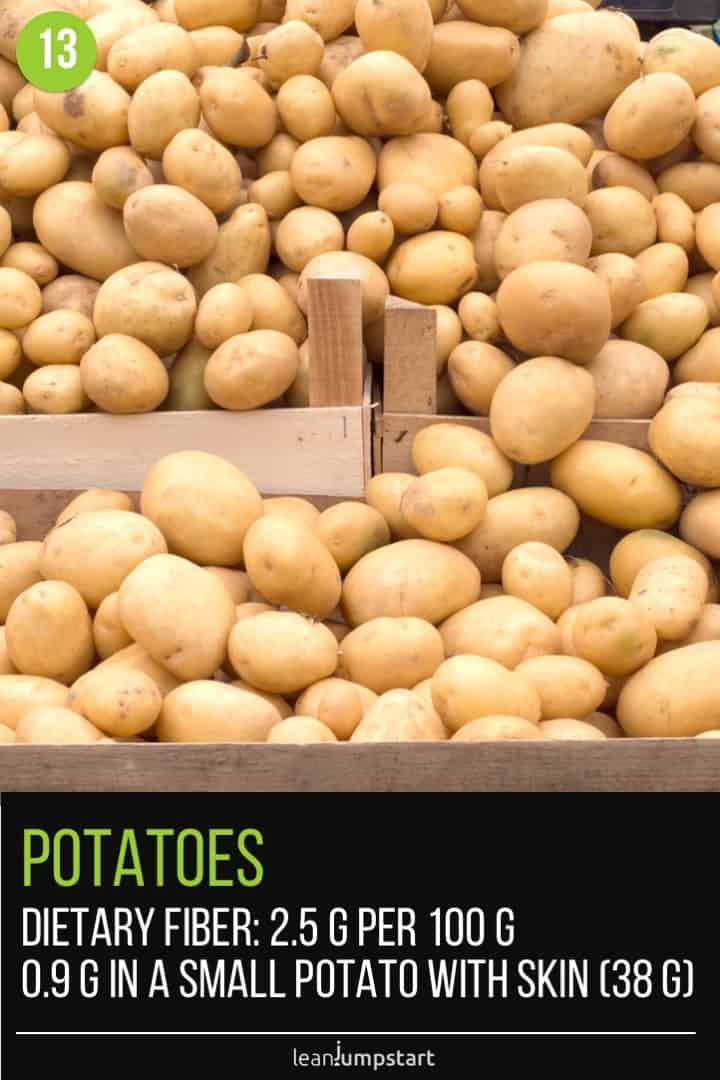
Although ranking at the lower end of the list, the fiber in white potatoes is still significant along with potassium and vitamins C and B-6.
It’s the resistant starch in potatoes that provides the benefits of soluble, fermentable fiber. Because they are not as easily digested, these resistant starch foods help people stay full longer.
Cold potatoes in a salad, for example, appear to be ideal for losing weight. When the potatoes cool down, part of the starch is converted into the dietary fiber inulin.
Fiber content: 2.5 g per 100 g (13), or 0.9 g in a potato with skin (38 grams)
My potato salad recipe is oil free and incredible tasty: Easy Potato Salad
14. Spinach, raw
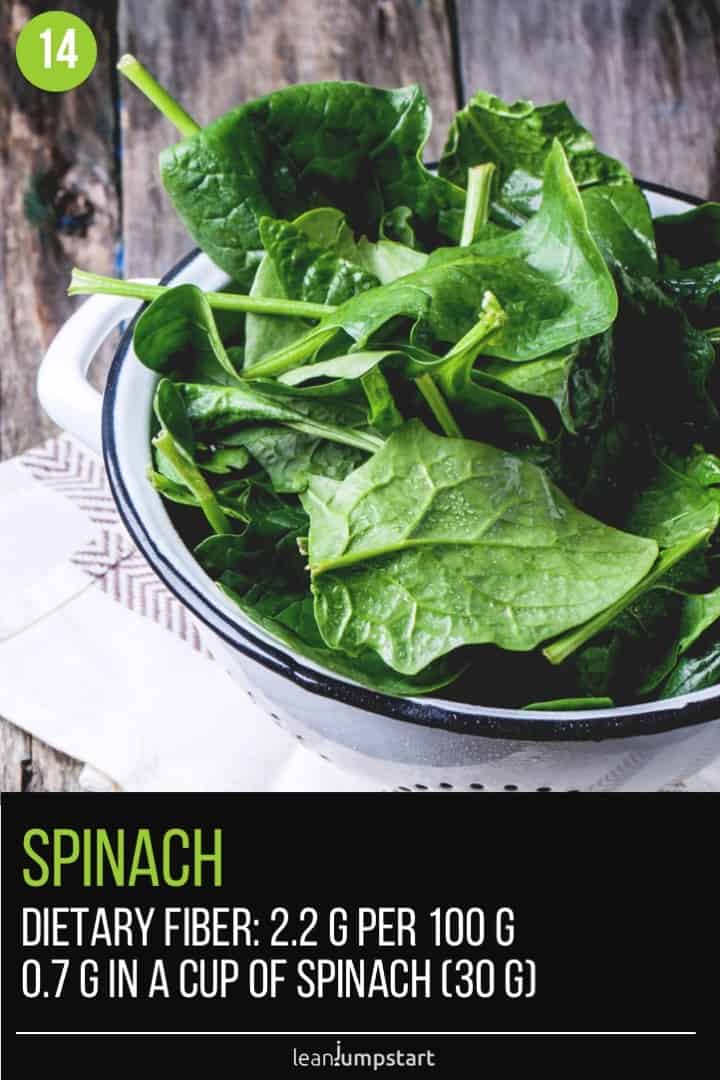
Typical insoluble fiber vegetables are green and leafy like spinach or kale. Insoluble fibers act as stool bulking agents that keep the bowels moving and protect against constipation.
While fiber in spinach is not as significant as in the veggies presented above, these green leaves can still be incorporated into many dishes without much effort.
Fiber content: 2.2 g per 100 g (14), or 0.7 g in a cup of spinach (30 g)
If you like the taste of Parmesan cheese then you’ll love this red bean soup with spinach
Top 9 veggies list
For your convenience, I’ve combined the top 9 into a chart that you can pin for later or share with family and friends.
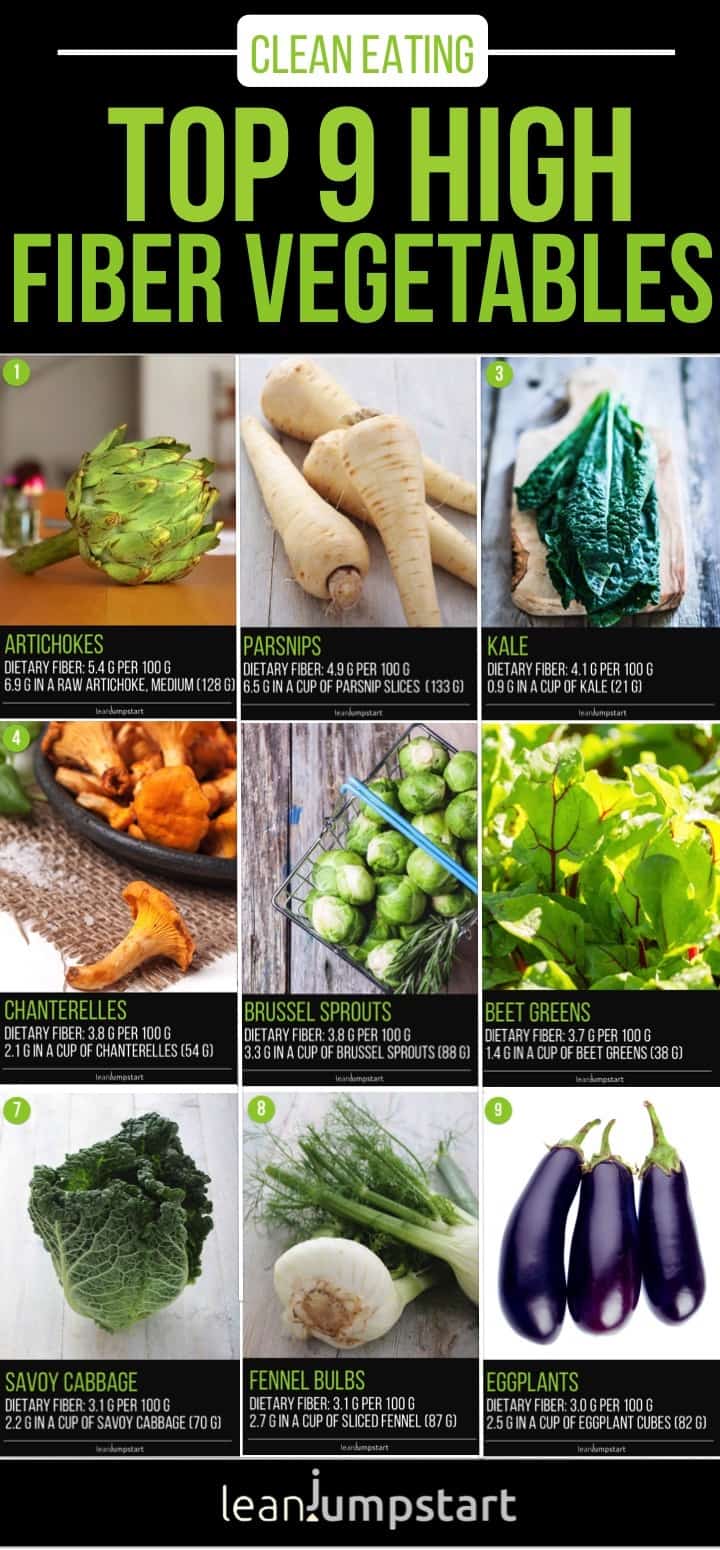
Top 30 fiber-rich vegetable list
The following list takes it to the next level ranking the top 30 fibrous vegetables.
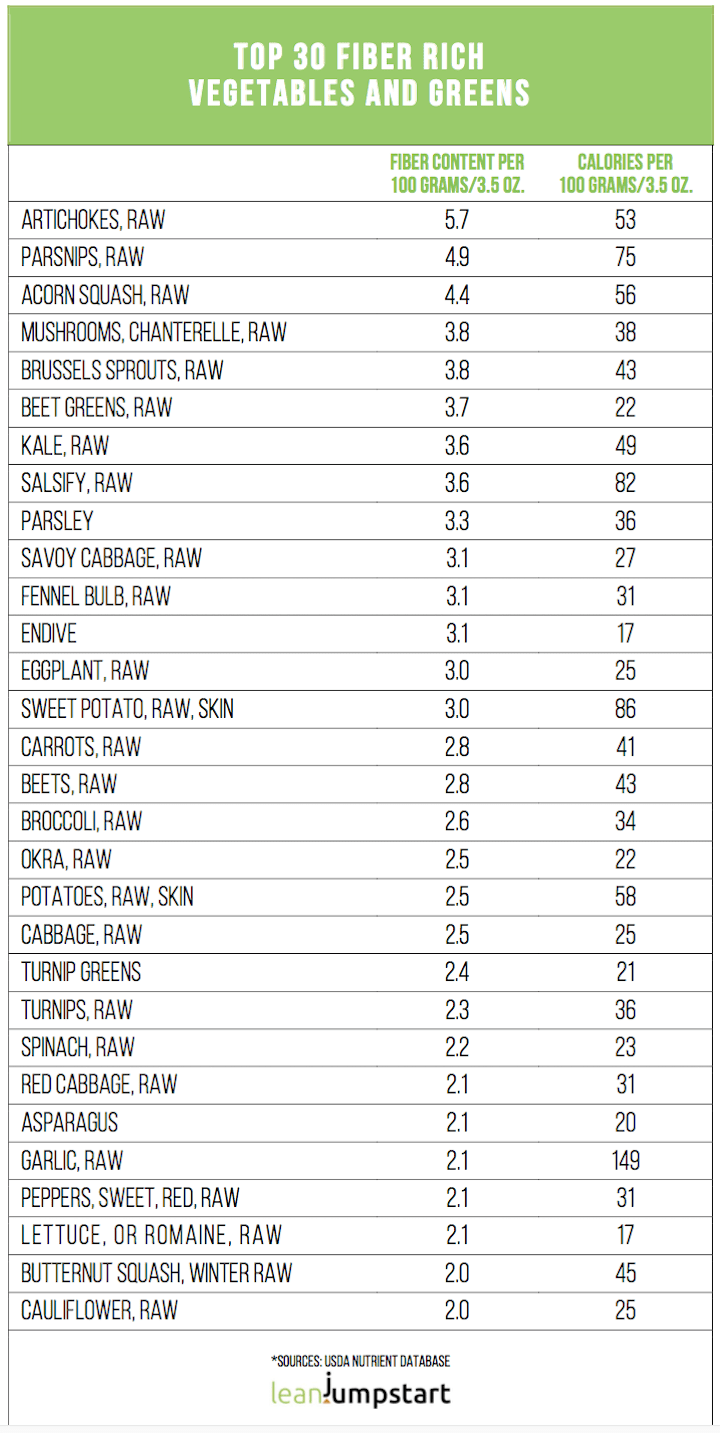
The weight loss properties of roughage
- They satisfy faster. Soluble fiber absorbs plenty of water and expands in the stomach. This makes us feel full earlier and we eat less.
- They attract signals of satiety. High fiber foods must be chewed intensively. This triggers satiety signals in the brain and additionally dampens the feeling of hunger.
- They slow down the release of the fat storage hormone insulin. Because high roughage foods ensure a slow increase in blood sugar, less insulin is released. The result: Your body burns fat instead of storing it in the fat cells.
- They act as “calorie blockers”. The gelling agents form a gel layer in the intestine, making it difficult to absorb calorie-rich components from food.
- They are low in calories. Soluble fiber supplies just 1.5 to 2.5 calories per gram. For comparison: carbohydrates and protein have 4 calories per gram, fat even 9.
Bottom line
Fresh fruits and veggies high in roughage stimulate our digestion, boost our metabolism and keep us full for a long time. Ideally, every meal should be accompanied by raw food and vegetables.
If you want to use a fiber-rich diet as a successful strategy for weight loss, you should include as many different vegetables to maximize your fiber intake. This will provide you with a wide range of nutrients. Don’t forget in this context also to include legumes like beans, lentils or split peas into your nutrition. Their complex carbohydrates combined with valuable plant protein provide plenty of health benefits and will you keep satiated for a long time.


Such a great guide, thanks for sharing your knowledge with us! Some of these, such as parsnips, I have not tried much of. I’ve made a mental note to use these veggies more often now!
Thank you for your kind words Shinta. An easy recipe to try out parsnips is the parsnip soup with potatoes I refer to in the post. It is a delicious and easy root soup perfect for the fall and winter season.
Such a wonderful guide for the best fibrous vegetables! Definitely appreciate the chart too. Carrots and sweet potatoes are especially my favorites this time of year.
Thank you Tara. You have great fall favorites. Sweet potatoes and carrots are thanks to their high beta carotene content good for eyesight, skin and hair.
Such a great guide to some amazing veggies. Always good to know which ones are more beneficial. Good to see some of my favourites on the list, and some that I would happlily include in our diet.
I’m glad to read that your favorites are on the list but also that my guide could inspire you to include other nutrient rich produce into your diet too.
I absolutely love this list!! Love all the nutritional information! I pretty munch everything listed except Brussels Sprouts, which isn’t bad! Thanks for the info!
My pleasure, Elaine! Maybe you should try my “Bang Bang Brussels sprout” recipe. It might change your mind:)
This is a super helpful list! I will keep these in mind when shopping for produce and so many are already ones that I buy!
It’s wonderful to read that you buy already most of those veggies, Urvashee. Well done!
what a great resource of info and love healthy vegetables being a vegetarian! thanks!
You are welcome Claudia! I’m glad that you as vegetarian like my resource.
Wow! This is so informative! I need to bookmark this post to accompany my meal planning efforts. Just pinned too! Thank you! 😉
You are welcome Traci. Thank you for pinning. I’m glad that this post can help you with your meal planning efforts:)
Great list of products! So many awesome produce to choose. My favorite are eggplants, carrots and sweet potatoes. I just need to combine them with leafy greens!
Wonderful choice of veggies Alina, I can imagine that you could create a hearty stew full of yum with this powerful produce combination.
What a fantastic informative guide on high fiber vegetables! You’ve encouraged me to pick up more fiber-rich vegetables next time I shop for groceries!
Thank you Marie. I’m glad that my guide could encourage you to make the right veggie choices on your next grocery shopping. Enjoy!